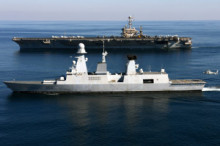
Americans have every right to ask: What is the United States’ role in today’s world? While there are many opinions among Americans – many of them at the far poles of internationalism and retrenchment – the thoughtful analysis in the National Intelligence Council’s Global Trends 2030 is worth considering.
Much has been made in the last decade regarding “America’s decline.” And given the current Washington gridlock, to say nothing of the shrill predictions of some pundits, one would think the United States is about to become a third-world power. It has become a debate that, while poorly-informed, makes up for it in passion.
Read more about America’s role in the world on the Defense Media Network website here.
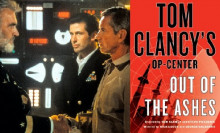
This year saw two “reboots” the Tom Clancy Op-Center series and another movie starring Jack Ryan – the fifth movie with “America’s action hero.” Adam Kepler put it this way in the New York Times.
Someone once said, “Never trust a man with two first names,” but that wit obviously was not referring to Jack Ryan, the C.I.A. analyst and reluctant action hero of Tom Clancy’s series of spy novels. The closest thing pop culture may have to an American James Bond, the character has appeared in four films, which were collectively rereleased in December by Paramount Home Video as “The Jack Ryan Collection.” And now he is the focus of a fifth, “Jack Ryan: Shadow Recruit,” which arrived in theaters in January of this year. It turns out that every era gets a Jack Ryan to fit the times.
Read more here.
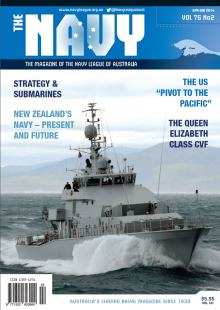
Much ink has been spilled discussing the United States “Rebalance to the Asia-Pacific region” or as it is known more colloquially – especially in naval circles, the “U.S. Pivot to the Pacific.” President Obama put it this way almost three years ago:
“Our new focus on this region reflects a fundamental truth – the United States has been, and always will be, a Pacific nation … Here, we see the future. With most of the world’s nuclear power and some half of humanity, Asia will largely define whether the century ahead will be marked by conflict or cooperation, needless suffering or human progress.”
President Barack Obama
Remarks to the Australian Parliament November 17, 2011.
In this prize-winning article in the Australian Navy League’s premier publication, The Navy, we examine whether this “pivot” is real or just rhetoric.

Social media surrounds us: at home, at work, at play, in our cars, on public transportation – even in our dreams. But is it causing us more anxiety than we can bear? Here’s what Bruce Feiler suggests:
We are deep enough into the social-media era to begin to recognize certain patterns among its users. Foremost among them is a mass anxiety of approval seeking and popularity tracking that seems far more suited to a high school prom than a high-functioning society. Mark Zuckerberg said recently that he wants Facebook to be about “loving the people we serve,” but too often his site and its peers seem far more interested in helping the people they serve seek the love they crave. ABC has also embraced the madness by picking up a comedy for the coming season called “Selfie,” about a woman in her 20s who is more concerned with her followers than her friends.
Read more here.
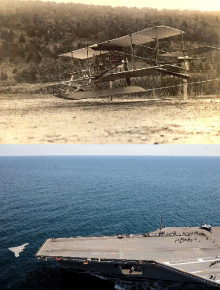
In outward appearance and the scope of their operations, they seemingly have nothing in common. While the A-1 Triad was constructed of wood and fabric with a top speed that would put it in the slow lane on a modern interstate highway, the X-47B Unmanned Combat Air System represents cutting edge technology. Yet, these aircraft, for what they represent to the development of naval aviation, are quite similar. Seminal moments in their service occurred in May during which the Navy this year celebrates the 103rd birthday of naval aviation.
Read more here

Authors James Parker and Anna Holmes debate the merits of book promotion in this Bookends section of the New York Times Sunday Book Review section in their combined piece entitled: “The Demands of Book Promotion: Frivolous or Necessary?” Both writers make good points, but Anna Holmes has, for me, the most compelling argument:
And the readers, really, are where it’s at. There’s nothing more rewarding than taking — or making — opportunities to connect with potential readers face to face or, thanks to the rise of the Internet, pixel to pixel. In fact, I consider book promotion as much of an obligation as proofreading a manuscript. Writing is, in itself, an act of engaging with others, of seeking connection over mere expression. If you were to put a book out into the world, which would you rather have — conversation or silence?
Read more here
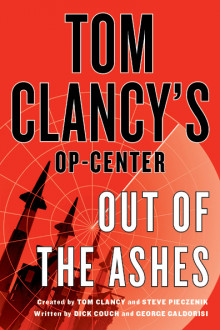
Kirkus Reviews had this to say about Tom Clancy’s Op-Center: Out of the Ashes:
Even when it’s been disbanded and its creator has died, you can’t keep a good agency down—especially when it’s as badly needed as Clancy’s National Crisis Management Center.”
Jeff Edwards, bestselling author of THE SEVENTH ANGEL and SWORD OF SHIVA, had this to say about Tom Clancy’s Op-Center: Out of the Ashes:
Op-Center is back with a vengeance! OUT OF THE ASHES isn’t just a reboot of the Op-Center series; it’s one of the best techno-thrillers to hit the shelves in a long time. Dick Couch and George Galdorisi have just raised the bar for military adventure fiction. Suit up, strap in, and hang on, because you’re in for one hell of a ride.

From the Information Dissemination website come two interesting and differing views of U.S. national security. Two well-known experts, Robert Kaplan and Usha Sahay, square off:
Kaplan stakes his claim here:
“But what about all those new global and regional institutions and organizations, to say nothing about the growth and opportunity that has come from financial markets? Aren’t they the other, more positive half of reality? They are. But then the question arises: Why have they been able to come into being in the first place? What ultimately undergirds them? The answer is one that many members of the global political and financial aristocracy do not want to hear: raw American power.”
“It is the various U.S. Navy fleets and numbered air forces that are the ultimate guarantor of stability in the key theaters of the globe…The U.S. Navy calls itself a global force for good. That claim would pass the most stringent editorial fact-checking process. Without that very naked American ambition, which allows the Navy and the Air Force to patrol the global commons, the world is reduced to the sum of its parts: a Japan and China, and a China and India, dangerously at odds and on the brink of war; a Middle East in far wider war and chaos; a Europe neutralized and emasculated by Russian Revanchism; and an Africa in even greater disarray.”
Sahay takes a different position here:
“It’s certainly true that America is changing its role on the world stage. But that’s not the same as retreating from that stage altogether. In fact, the opposite is true: by many measures, the Obama administration has increased American engagement with the world. What has changed is not the amount of engagement, but its nature. Obama has sought to re-orient our foreign policy away from a military-first approach, and toward a more comprehensive approach that leans more on diplomatic and economic tools.”
“Critics who believe that Obama has pulled back from the world stage are confusing quantitative changes in the nature of U.S. engagement with a qualitative decline in that engagement.”
Read both articles. For Kaplan, it is hard power that ultimately backs up diplomatic engagement. For Sahay-who not once, but twice, refers to pre-Obama foreign policy is terms of “militarism”, engagement is self-perpetuating.
Kaplan
Sahay

New platforms may not always be the answer to rising military technology needs, according to strategic guidance just issued by the Pentagon’s research and engineering office. “In the near past, technology surprise” came from systems like revolutionary airplanes or ships, states the document. In the near future, “operational advantage may well come from new technologies and capabilities, or from new ways to use existing technologies that enhance and enable” existing platforms.
The research and engineering enterprise will be putting its limited funds to work on many enablers, such as ways to lower lifecycle costs, smart design, prototyping, and risk reduction. The next generation of technology surprises the United States may spring on its adversaries will also likely flow from quantum technologies, nano-engineered materials and devices, new sensors, autonomous systems like unmanned vehicles, and timekeeping/navigation devices that will far outstrip the abilities of GPS, states the document, dated May 1. The latter will likely be attacked and possibly “denied” by adept enemies.
Read more here
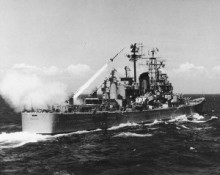
Today, the U.S. Navy leads the pack in the national imperative of providing missile defense. It has been a long journey. While the U.S. Navy has enjoyed unprecedented success in developing surface-to-air missiles for fleet air defense the path to success was not a linear one, but one that proceeded by trial and error, and in the early days, impelled by war, always pushing the outer limits of technological development. And while this is a story about more than just technology, as Max Boot points out in his best-selling War Made New, “My view is that technology sets the parameters of the possible; it creates the potential for a military revolution.” And indeed, the Navy’s journey to field effective fleet air defense has represented both an evolutionary and revolutionary approach.
Read more here on Defense Media Network










